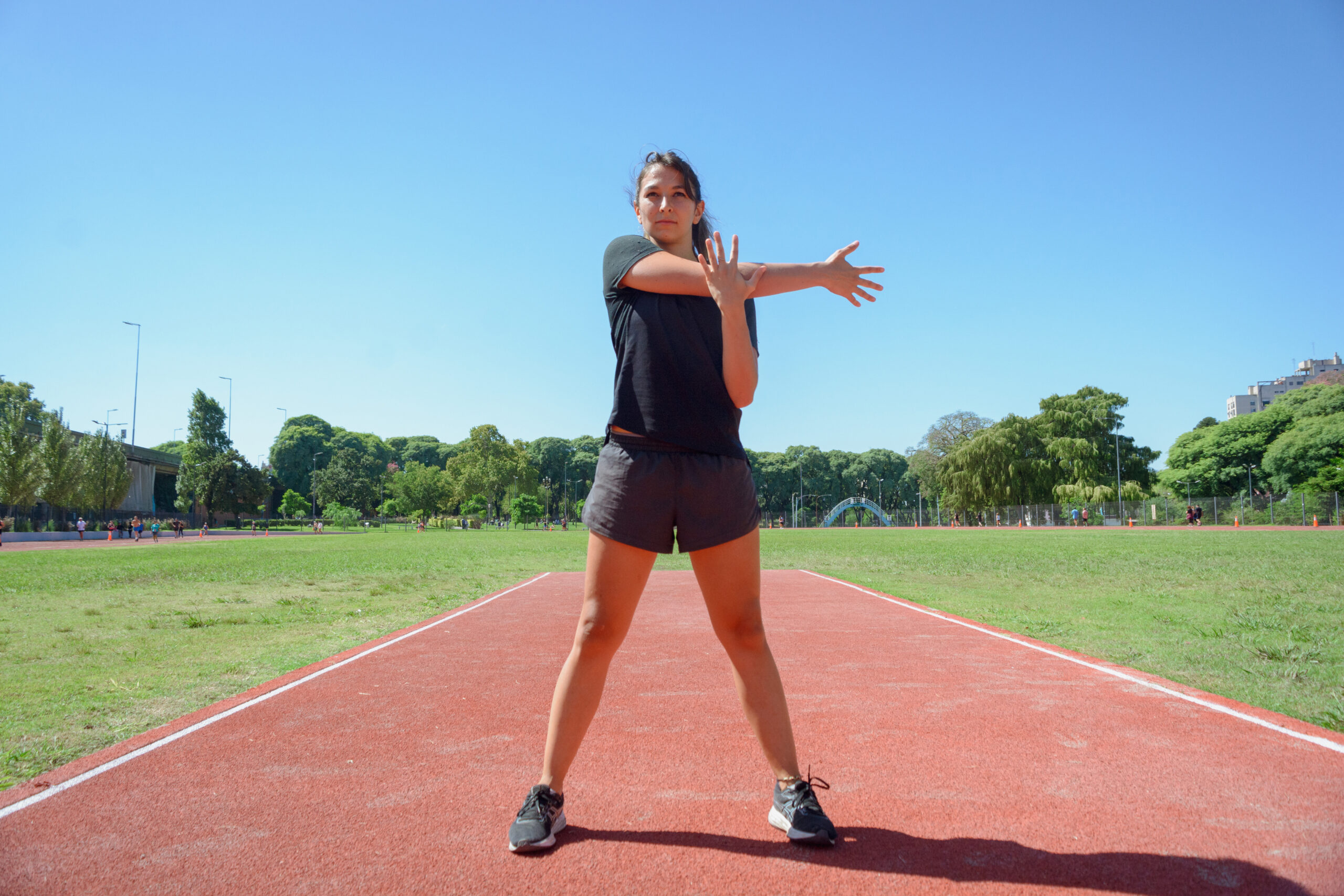Wondering how to start your run right with a solid warm-up? Let me share what works for me
As a running coach, I can’t tell you how many times I’ve seen runners skip warming up, only to end up tight, sore, or even sidelined with injuries.
I used to be one of those runners—lacing up, heading straight out the door, and hoping for the best.
It took me a few scares and even a minor hamstring strain to finally realize how crucial it is to warm up right before I hit the road
Let me walk you through how to warm up properly for your runs and workouts.
What is A Dynamic Warm-up?
Dynamic warm-ups mean you’re stretching with movement, getting your muscles ready to roll.
Unlike static stretching (which involves holding a stretch for 20-30 seconds), a dynamic warm-up is about movement. You’re essentially “warming up” your muscles and joints by taking them through the full range of motion you’ll use while running.
A good warm-up has two simple phases that cover all you need to feel ready:
- General Warm-Up. This phase is all about waking up your muscles and getting the blood moving. The idea is to wake up your muscles, get your heart rate up, and increase circulation to your legs, core, and upper body. You can start with light activity, such as brisk walking, jogging, or running in place. Think of this as the prep work that primes your body for the more intense exercises.
- Specific Warm-Up. This phase focuses on movements that mimic the biomechanics of running. You’ll target the specific muscles you’ll be using during your run, like your quads, hamstrings, glutes, and calves. This is where dynamic stretches come in. These exercises wake up your nervous system, fire up your muscles, and ensure everything moves smoothly when you start running.
A running buddy introduced me to dynamic warm-ups, and it was a total game-changer. At first, I thought it was a bit of overkill—I mean, who has time for all these exercises before every run?
But after doing them consistently for a few weeks, I noticed a huge difference. I felt looser and more energized at the start of my runs, but I also found that my body felt more prepared for those tough hill workouts or speed intervals.
One of the moves that made a difference for me was butt kicks. It sounds simple, but kicking your heels up towards your glutes gets your legs ready for the motion of running.
I remember feeling silly doing them in the park the first few times, but now they’re a regular part of my pre-run routine.
Benefits Of Dynamic Running Warm-ups
First, let’s get this straight: warming up isn’t just something “extra” you do before a workout. It’s an essential part of the workout itself.
Here’s why:
- Prevents Injury. Keeping injuries at bay is the best part of warming up right; cold muscles are just begging for trouble. Warming up increases blood flow to your muscles, making them more flexible and reducing the risk of injury. Once I started doing regular warm-ups, I noticed fewer aches and less tightness, especially in my hamstrings and calves.
- Improves Performance. Warming up prepares your body for action, which means you’ll run more efficiently and with better form. When properly warmed up, your muscles contract and relax more easily, which helps you run faster and longer. It’s not just about avoiding injury—warming up can make your run easier and more enjoyable.
- Gets Your Heart Rate Up. A proper warm-up increases your heart rate gradually, preparing your cardiovascular system for the work ahead. If you’ve ever started a run feeling sluggish or like your legs won’t move, it might be because you didn’t warm up properly. When you ease into your workout, you’re allowing your body to adjust and perform at its best.
How To Warm Up Before Running
Here’s a warm-up routine I recommend to my running friends. These exercises target the major muscle groups used in running, increase your heart rate, and improve flexibility and mobility.
Let’s break it down.
A good dynamic warm-up usually takes about 10 to 15 minutes. This includes 5 minutes of light aerobic activity (walking or jogging) followed by 5 to 10 minutes of dynamic exercises. If you’re doing a more intense workout, like sprints or hill repeats, you might need a longer warm-up of up to 15 minutes to activate everything properly.
For easier runs, like a recovery day, you can shorten your warm-up slightly, but I still recommend spending at least 5 minutes doing dynamic movements. Even on easy days, I always warm up to ensure I’m not starting with tight muscles.
I also recommend the Myrtle Routine for warm-up.
Toy Soldier Kicks
Toy Soldiers are great for warming up your hamstrings, glutes, and core. They also improve flexibility in the backs of your legs, which is crucial for runners, especially if you tend to get tight hamstrings (like I do!).
It also helps improve coordination, which is key for maintaining good form during your run.
How to do it:
- Stand tall with your arms extended out in front of you.
- Step forward with your right leg, keep your knee straight, and kick your leg towards your hand.
- Try to kick as high as possible while keeping your core tight and back straight.
- Alternate legs and repeat for 10 to 12 kicks on each side.
Side Step/Shuffle
This move is a lateral movement, which we don’t do often in running but is important for overall balance and injury prevention.
Side shuffles are great for activating your glutes and improving lateral stability. This is important for runners because it strengthens the muscles around your hips, which helps with balance and can prevent injuries like IT band syndrome.
How to do it:
- Stand with your feet hip-width apart.
- Step to the side, performing quick side shuffles for 10 to 15 meters.
- Land on your right foot and pause, then shuffle back to the left.
- Repeat for 2 to 3 sets.
Side-to-side Leg Swings
Leg swings are one of my favorite dynamic stretches because they loosen up the hips, essential for a smooth running stride. Tight hips are a common problem for runners, especially if you sit for long periods during the day.
How to do it:
- Stand next to a wall or sturdy surface for support.
- Swing your right leg from side to side across your body keeps your core engaged and the movement controlled.
- Do 10 to 12 swings on each leg.
Lateral Lunge
Lateral lunges strengthen the glutes, quads, and adductors while improving mobility in the hips and knees. This is crucial for runners who must maintain balance and control throughout their stride. I find lateral lunges help me feel more stable during my runs, especially on uneven terrain.
How to do it:
- Start in a standing position with feet hip-width apart.
- Step to the side with your right foot, bending your right knee and pushing your hips back to lower into a lunge.
- Keep your left leg straight and your back flat.
- Push off with your right foot to return to the starting position, then switch sides.
- Make 12 lunges on each leg.
Walking Lunges
Walking lunges are one of the best dynamic exercises for runners because they engage your entire lower body and core. This move targets your quads, hamstrings, glutes, and hip flexors. It also helps improve your range of motion, which is important for runners who need fluid movement through their entire stride.
How to do it:
- Step forward with your right foot into a deep lunge, lowering your left knee toward the ground.
- Push off with your left foot and step forward into the next lunge with your left leg.
- Repeat for 10 to 12 lunges on each leg.
Butt Kicks
Butt kicks may look funny, but they do wonders for firing up those hamstrings and refining your running form.
How to do it:
- Jog in place while bringing your heels up to kick your butt.
- Keep your knees low and focus on quick, light steps.
- Do this for 30 seconds to 1 minute.
Conclusion
If you’re new to warming up, I’d recommend starting with simple moves like walking lunges or side leg swings. It doesn’t take long—just 10 minutes before your run can make a huge difference.
Over time, you can add more dynamic exercises and tailor your routine based on how your body feels that day. For example, if I feel tight in my hips, I’ll spend more time on hip mobility exercises.
What Are Your Go-To Warm-Up Moves?
Do you have a favorite stretch, dynamic exercise, or sequence that gets you ready to run? Maybe there’s a routine that’s helped you avoid injuries or feel more energized.
Share your favorite moves, tips, and any advice you have for warming up effectively.



